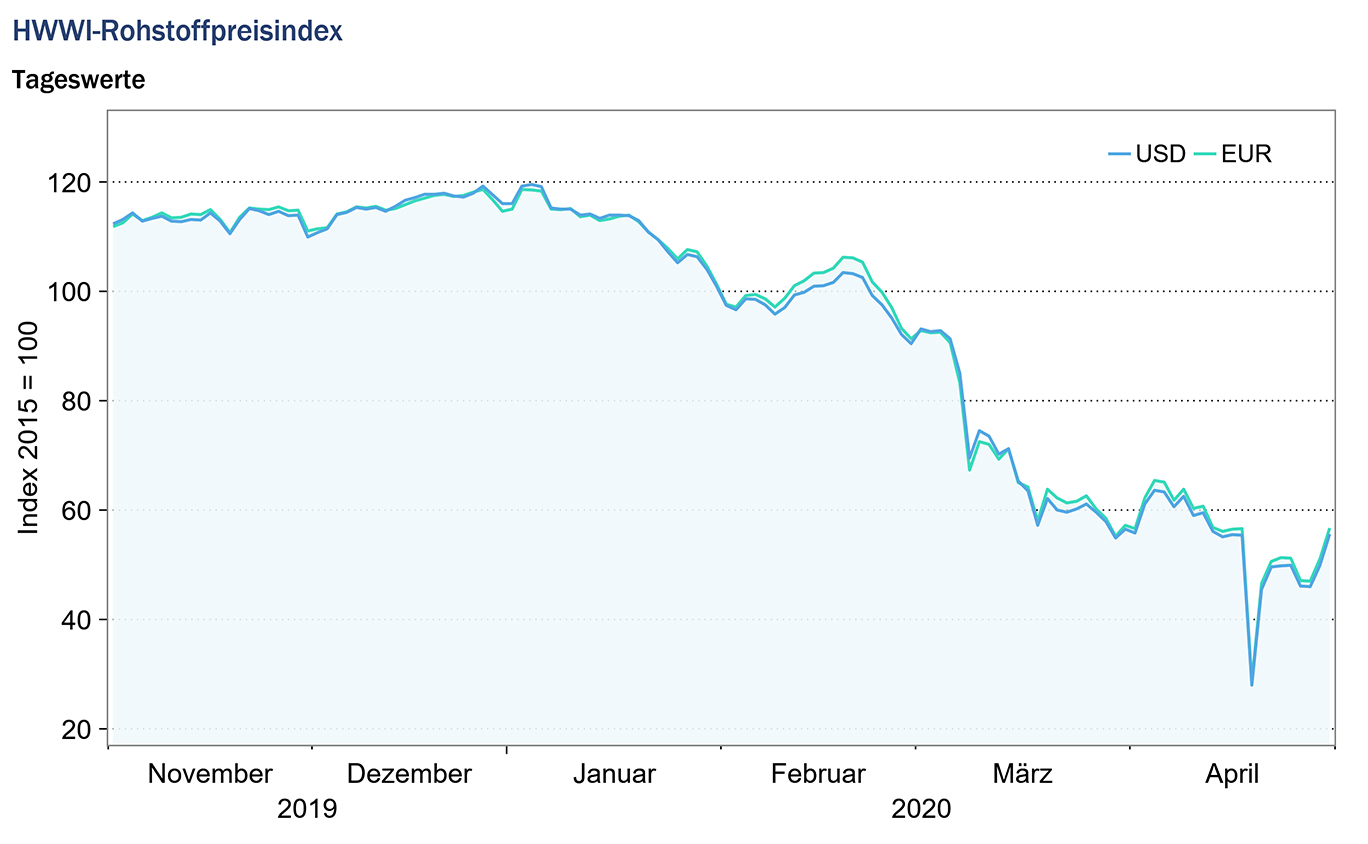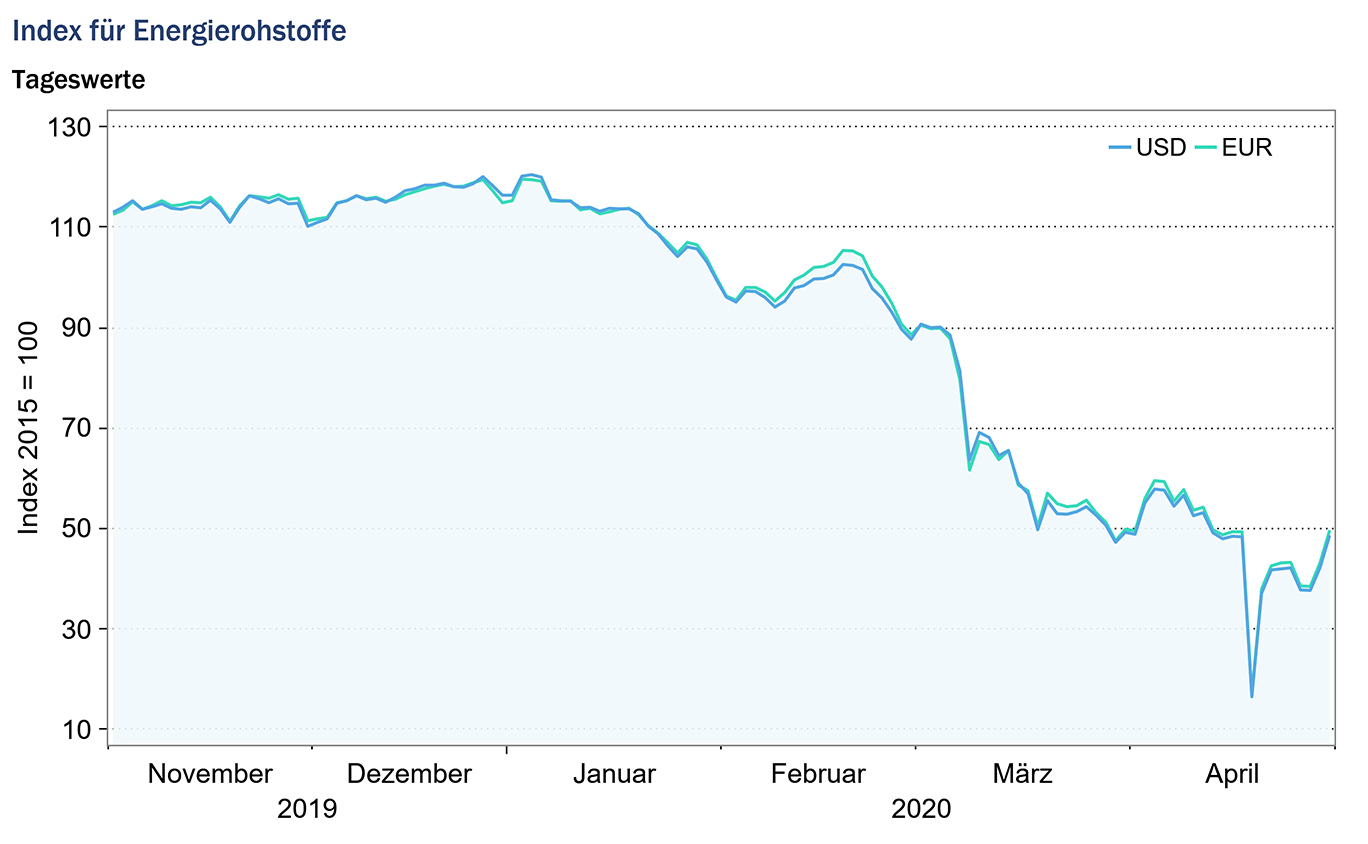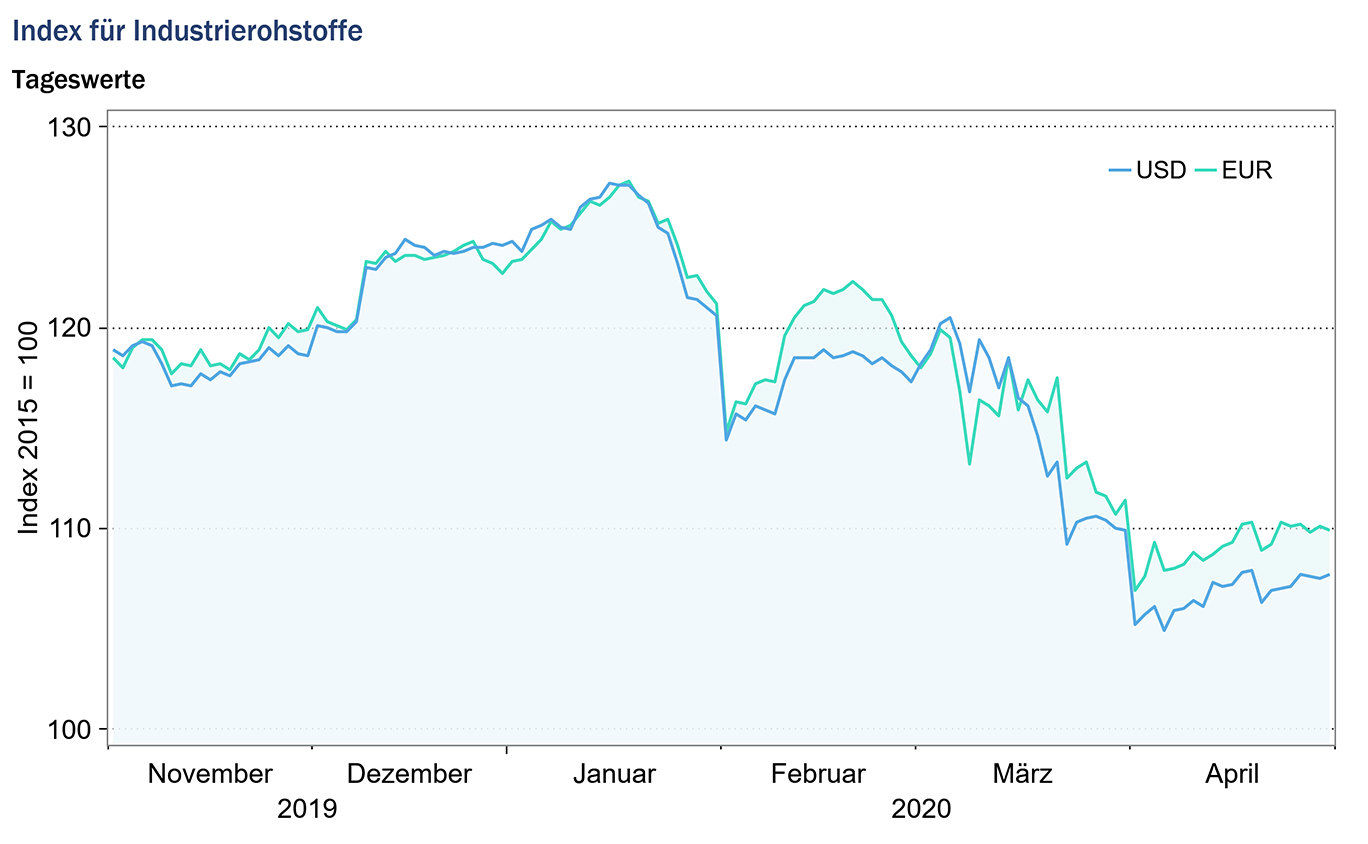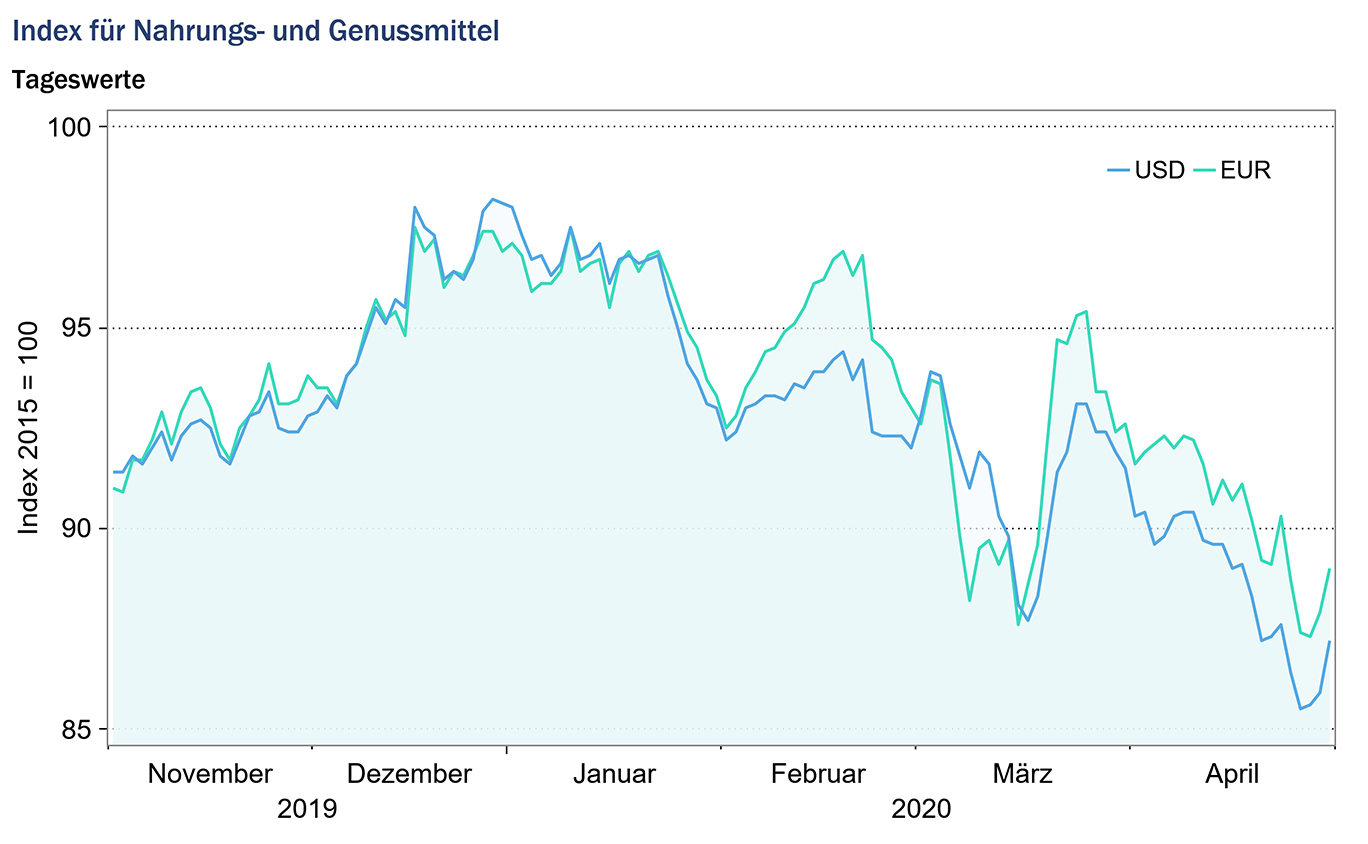HWWI commodity price index continued to record strong price losses
- HWWI overall index fell by 22.9 % (US dollar basis)
- Crude oil prices have fallen by 31.6
- 7.2 % decline in prices on the markets for industrial raw materials
(Hamburg, May 12, 2020) The HWWI commodity price index fell in April by an average of 22.9% (euro basis: -21.3%) compared to the previous month and stood at 53.7 points (euro basis: 54.9 points). The ongoing corona crisis continued to have a significant impact on developments on the global commodity markets in April, causing sharp price losses. The global curfews imposed worldwide slowed down the global economy and resulted in all indices included in the HWWI commodity price index falling on average in April compared to the previous month. The strongest fall in April was recorded by the sub-index for energy commodities, which fell by an average of -27.4 % (euro basis: -25.9 %) to 46.4 points (euro basis: 47.4 points). The index for industrial raw materials fell by 7.2% (euro basis: -5.5%) to 106.7 points (euro basis: 109.1 points) and the index for food and beverages by 3.2% (euro basis: -1.4%) to 88.5 points (euro basis: 90.4 points). Compared to the previous month, the index excluding energy fell on average by 5.8% (Euro basis: -4.0%) to 99.3 points (Euro basis: 101.4 points).

Index for energy commodities: -27.4 % (euro basis: -25.9 %)
In April, developments on the crude oil markets were again dominated by the effects of the Corona crisis. The global lockdown to contain the corona pandemic continued to reduce global demand for crude oil and the downward trend on crude oil markets continued. At the beginning of April, further negotiations were held by the OPEC+ countries with the aim of reaching agreement in the price war between Saudi Arabia and Russia, which has been ongoing since March and agreeing further production cuts. In order to counteract the drop in prices on the crude oil markets, the oil cartel agreed to cut production by 9.7 million barrels per day for May and June. Further production limits were announced until April 30, 2022. In April, the announcements by OPEC+ did not yet lead to any price increases, so that all crude oil prices included in the index fell significantly compared to the previous month.
The price of the American crude oil grade WTI showed a special trend in April; it recorded negative prices for the first time. The price of WTI crude oil slid to USD -37.63 per barrel on 20 April. The extraordinary price drop was due to the expiry of the May futures contract and exhausted storage capacity. Crude oil traders who held a buy position on the futures market for the May expiring crude oil contract wanted to sell it before maturity in order not to have the physical crude oil delivered. Due to filled crude oil inventories and low demand caused by the Corona crisis, it proved difficult to find buyers for these positions. For the first time, the price fell into the red, so that traders had to pay to have the oil taken from them. The price of WTI crude oil remained negative for only a short time and rose again the very next day. Overall, the prices of all three types of crude oil included in the index fell significantly in April, recording an average price decline of over 31.2% compared with the previous month (euro basis: -29.8%).
European and American natural gas prices developed in opposite directions in April. While European natural gas prices fell sharply, prices for American natural gas rose slightly. The development of prices for American natural gas is dependent on the development of American crude oil prices, since American fracking gas is a by-product of shale oil production. Due to the sharp drop in crude oil prices, US shale oil producers reduced their capacities and cut back on capital expenditure, which in turn also reduced US natural gas supply and led to rising prices. In contrast, the falling trend in European natural gas prices is due to the mild winter and well-filled natural gas storage facilities. The collapse in industrial demand due to the corona lockdown led to falling prices for European natural gas.
Enormous price losses were also observed on the coal market in April. Here, too, the reasons are to be found in the paralysed industry worldwide and the associated collapse in demand for coal.
Overall, the sub-index for energy commodities fell by -27.4 % (euro basis: -25.9 %) to 46.4 points (euro basis: 47.4 points).

Index for industrial raw materials: -7.2 % (Euro basis: -5.5 %)
The sub-index for industrial raw materials is divided into the index for agricultural raw materials, the index for non-ferrous metals and the index for iron ore and steel scrap. The fall in prices on the markets for industrial raw materials intensified in April compared with the previous month. All three sub-indices recorded price losses due to the global lockdown and the resulting drop in demand.
The downward trend in the index for agricultural commodities continued in April, as the textile industry continued to be strongly affected by the global corona restrictions. The slowdown in production led to declines in demand and price reductions in the cotton, wool and hides markets.
Base metal prices also fell in April, although the average negative growth slowed compared to March. The Chinese industry slowly returned to normality and increased demand in the base metals markets.
Lead and aluminium prices continued to fall relatively sharply on a monthly average. For example, the paralysed automobile industry caused a drop in demand for aluminium, resulting in a price drop of almost 10% (euro basis: -7.9%) compared to the previous month.
Iron ore prices, which still rose in March due to supply bottlenecks, fell again in April due to the drop in demand from Europe, South Korea, Japan and the USA caused by the lockdowns there. Although the ongoing recovery of the Chinese economy led to a slight recovery in steel production and thus to increased demand for iron ore, supply from the Chinese iron ore mines increased at the same time, which were reopened by the easing of the Chinese lockdown. Steel scrap prices also fell on average in April due to the downsized steel industry. Overall, the index for iron ore and steel scrap fell in April by an average of -6.4% (euro basis: -4.7%) compared with the previous month.
Overall, the index for industrial raw materials fell by an average of 7.2% (euro basis: -5.5%) to 106.7 points (euro basis: 109.1 points).

Index for food and beverages: -3.2% (euro base: -1.4%)
Compared with developments in the other sub-indices, the index for food, beverages and tobacco continued to fall by a relatively small 3.2% in April (euro basis: -1.4%). While the prices of sugar and maize fell significantly, the prices of barley, wheat and rice rose.
As in the previous month, the prices for sugar and corn also showed a significant decline in April. The worldwide slump in demand for fuels, caused by the corona crisis, led to a collapse in biofuel production and thus also to a decline in demand for corn and sugar. Similarly, the average price of palm oil fell in April, also reflecting the collapse in demand for biodiesel.
In contrast, prices for staple foods such as barley, wheat and rice rose significantly in April compared to the previous month. Many countries increased their purchases of staple foods to counteract possible food shortages due to the corona crisis. The worldwide curfews imposed restrict the availability of labor, which could lead to problems in harvesting these commodities.
Overall, the index for food and beverages fell by -3.2 % on a monthly average (euro basis: -1.4 %) and stood at 88.5 points (euro basis: 90.4 points).

Source: www.hwwi.org
